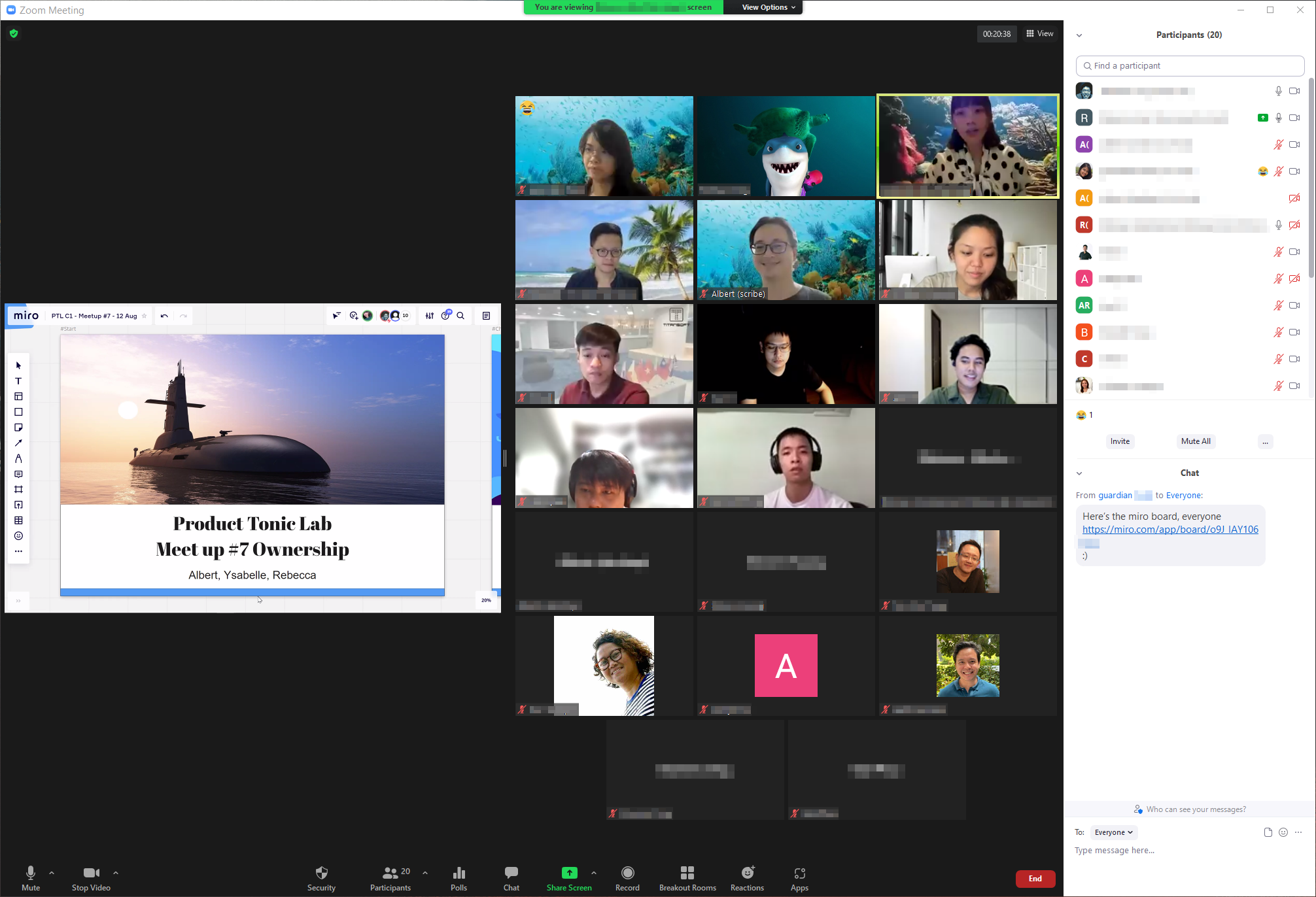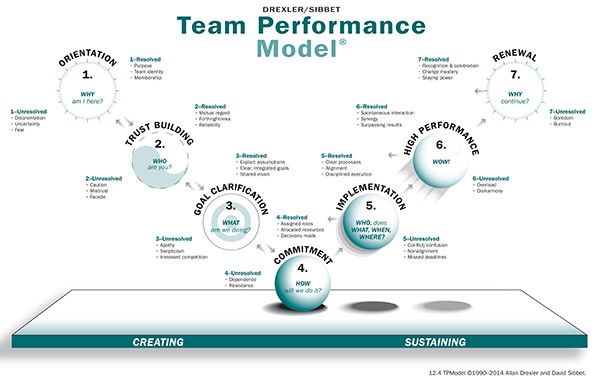PTL #7 - Ownership
“How might we build a sense of ownership to create success together?”

Facilitated by Albert, Rebecca, Ysabelle
What we learnt and shared:
- Building a sense of ownership starts with invitations
- The Game of Ownership (Shark Tank)
- Recognising stages of team development to identify blockers and the right resolutions
Building a sense of ownership starts with invitations
Invitation can test willingness & “pull” people to make choices instead of delegating / “pushing” action or responsibilities onto them. By offering choices (including free will to opt-in / out), we demonstrate respect and likely attract motivated people, increase engagement, strengthen trust and relationships.
The Game of Ownership
We played a game constructed to see how leadership, invitation and ownership could play out in the team. The game was loosely inspired by the TV Show “Shark Tank” about entrepreneurs making business presentations to a panel of investors.

2 teams were deliberately setup: one with an “ideal” situation of a supportive Product Owner, motivated interns and has unlimited resources, whereas the other team were put together last minute in “hot seats” with an uncooperative Product Owner (with hidden agenda, poor leadership and ownership).
We also randomly invited 4 interns to play special behavior variants to bring either a positive or negative energy in both teams to observe how energy could impact the team’s ability to self-organise & self-manage. The rest of the members were invited as observers to notice how ownership emerges in each team in getting things done.
What we have learned in running the game:
- Unexpected challenges to get volunteers taking PO roles - Perhaps because we underestimated stigma, uncertainty and perceived accountability of the role play “Sticky situation” between the urge to taking shortcuts to move on from impasse situation (by arrowing PO) and holding the space for learning process to emerge
- Huge relief when members stepped up and volunteer to hold on to the “cactus” (be it as PO or Presenters) - In hindsight, this is probably the best outcome because those volunteers will have both motivation and legitimacy as leader as compared if we are to appoint them
- Both teams prevail and manage to deliver their pitch despite obstacles. There’s no lack of creativity and improvisations - including last minute presentations being created! Most heartwarming is to see how the rest of the members are cheering and rallying behind them.
- As shared by observers - challenging situations provides opportunity for leadership to naturally emerge
- Even with our invitation sharing, only 1 member has clear awareness that they can say no, others are trying to make things done.
Stages of Team Development to unite and create success together
Moving from how individuals can solicit and embrace ownership, we looked into how groups of people can self-organise as a team. We became aware of the tension between taking ownership, providing autonomy (freedom to act independently of others), ensuring alignment (pushing towards the same goal) and upholding accountability.

A model that resonated with us is “The Drexler-Sibbet Team Performance Model” which describes “predictable progression of concerns that will help us understand how people come to work together as a team and eventually achieve increasing levels of performance”.
This model helped us reflect where we are in the process to identify gaps that hindered our progress.
What worked well:
- “Create common ground”: Our team was formed almost by circumstance rather than by choice. However, all of us took that “leap of faith” when we realised that we shared pain points that we are all motivated to solve. We also strengthened our common ground by identifying what we are bringing to the team and creating an accepting environment for sharing.
- “Take the time to build trust”: We felt a mutual regard with each other when we put effort into preparing for meetings, reflecting deeply on THE WHY of this topic, and giving each other feedback. At the same time, there are times when we are cautious as we may not personally feel confident enough with others to drive specific ideas.
- “Align and Focus”: The topic is HUGE. With so much research possibilities, we felt disoriented due to lack of focus. However, by clarifying our shared assumptions and expectations, we refined our goals on the topic of “ownership” which strengthened our team alignment.
What didn’t work so well:
- Given our early start (in May), we became complacent of time - took for granted the time to perform autonomous / independent research work (e.g. reading up materials, exploring possible avenues about the topic) without clearly assigning roles, goals & commitments. We underestimated how fast time passes and found ourselves fast-forwarded to D-3 weeks!
- “Unbounded Autonomy”: Deadline has suddenly become a constraint to work autonomously as well as an ally in realigning our actions. We switchded gears from once-in-a-while meetings to daily meetups :) In hindsight, we might have lowered our “stress” by having shorter, more regular alignment sessions.
- “Absence of Strategy”: We found it disorienting without strategy as we didn’t have a reference model for what to do & how we should self-organise. These challenges helped us realise how we can use The Performance Model to see where we were stuck, evaluate, and resolve.
What actions we made for team growth:
- “Show up”: With the deadline looming, we created working agreements to commit daily evening updates and keep each other accountable. It was quite an effort, but all of these interactions, commitments help us appreciate each others’ sincerity, reliability, competence and charge our “trust battery”
- “Build on one another - make progress together”: There are many different ideas that we initially attempted to explore - but eventually it boils down to how they fit the constraints of run sheets. We stopped creating individual note boards and started making actual meetup placeholders / slides. We also agreed on daily tasks to accomplish by next day’s meeting and build upon each other’s work. Doing so helped us move from “individual ownership” (i.e. your work vs my work) into “group ownership” (i.e. our work)
- “Rest to Persevere”: We experienced a high sense of progress before being “brought down to reality” when we had the test run at D-7: significantly increasing anxiety, frustration, and tension. Recognising that burning the midnight oil has taken a toll on our personal energy, we collectively decided to take a much needed weekend break. By choosing to rest & stopping “maximising efficiency”, prioritising connection and finding back our clarity that we all want to deliver “fun” and meaningful meetup helps us reset and bounce back.
Members’ AHAs:
- Ownership takes courage - i.e. to take the leap of faith, to trust and to hold a space for others to step up and flourish. It was encouraging and heartwarming when that moment happened.
- Trust yourself, trust your members, trust your audience. They will bring you more than you ever expect. Even if things didn’t go the direction we planned, or are not in your comfort zone, it is still worth it to jump in and give it a try. It might be related to real life when evolving and building a team, related to our “invitation” as well - The best lesson is always about self-discovering, creating stories together but not storying-listening.
- Don’t underestimate how fast time flies. Don’t overestimate how much 1 motivated individual can do – a chain is only as strong as its weakest link.
Side Quest
Inviting Leadership and The Culture Game
Describes how good invitation should be formed and how invitation relates to leadership, authority, and boundary. We could not get to read the actual book, so we read snippets of it in the following links.
This book prescribes that “the best leaders don’t just take responsibility for their job. They take extreme ownership of everything that impacts their mission. All responsibility for success and failure rests with the leader. Whether a team succeeds or fails is all up to the leader. The leader’s attitude sets the tone for the entire team”. It highlights roles and responsibilities for leaders to first demonstrate ownership before expecting ownership.
Along the line Inviting Leadership, this book highlighted how choosing the right words can dramatically improve commitment, decision-making and execution on a team. I particularly found the proposed playbook insightful. One example related to ownership: If you want to keep your commitments, don’t make it about the behavior but more about who you are. Not, “I can’t,” but rather, “I don’t.” A way to execute this play is to focus on learning by “developing hypotheses to test rather than making decisions to execute.” Rather than “What are we going to do?” create a mindset of “What are we going to learn?”
“Cactus Role” is a relevant analogy for embracing ownership and leadership since it is indeed challenging - This book gives me a good reminder that “Leadership is not a license to do less; it is a responsibility to do more… The effects are not always easily measured and they are not always immediate. Leadership is always a commitment to human beings… Leaders eat last”